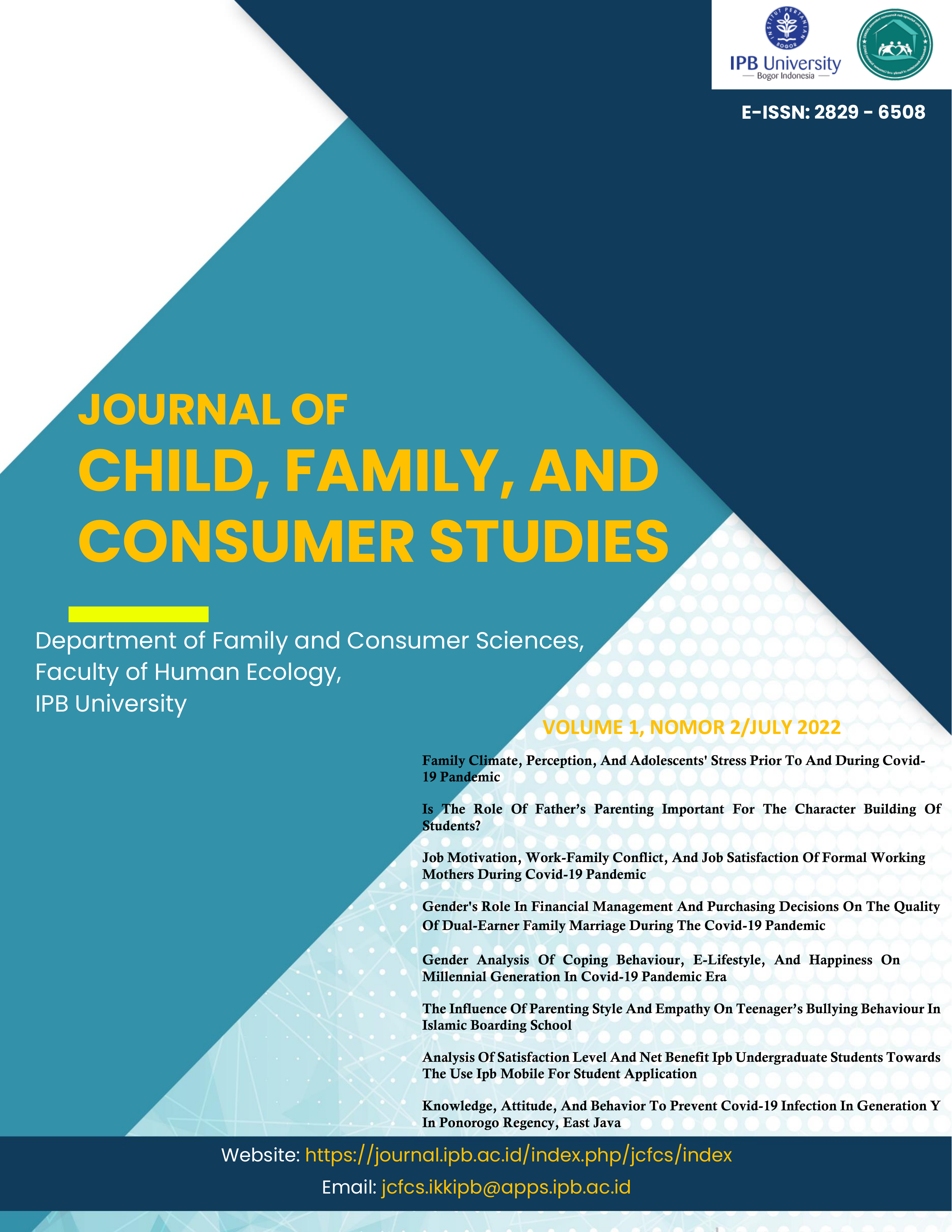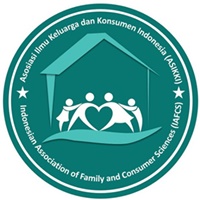ANALYSIS OF SATISFACTION LEVEL AND NET BENEFIT IPB UNDERGRADUATE STUDENTS TOWARDS THE USE IPB MOBILE FOR STUDENT APPLICATION
Abstract
IPB University implements a mobile-based management information system through the IPB Mobile for Student application to bring technological innovation closer and realize transformation into a digital campus. This study aims to analyze the perception of quality, level of satisfaction and net benefit felt by S1 IPB students towards the IPB Mobile for Student application. This research is a quantitative research using explanatory design. This research was conducted on IPB students using voluntary sampling techniques so that 306 respondents were obtained. Data is collected through tools in the form of questionnaires that are distributed online using google forms. The data obtained were processed using Microsoft Excel, SPSS version 25, and SEM-LISREL 8.80. The results of the influence test showed a positive and significant influence on the perception of quality on user satisfaction and user satisfaction had a significant positive effect on net benefits. The advice that can be given is that users are expected to provide input on the shortcomings in the application so that IPB University as an application developer can improve the quality of the IPB Mobile for Student application.
References
Aini, Q., Lutfiani, N., & Zahran, M. S. (2021). Blockchain technology-based ilearning gamification analysis. ADI Interdisciplinary Digital Business Journal, 2(1), 79-85.
Amalia, N. (2019). Factors affecting the use of e-ticket booking applications and their impact on "net benefits" (Case study on Traveloka website). [thesis]. Yogyakarta: Universitas Islam Indonesia.
Amarin, S., & Wijaksana, T. I. (2021). The Effect of System Quality, Information Quality, and Service Quality on Consumer Satisfaction (Study on Berrybenka Application Users in Bandung City). Business Management Analysis Journal (BMAJ), 4(1), 37-52. Retrieved from http://libraryaplos.com/xmlui/handle/123456789/6337
Ameylda, N. (2020). The level of satisfaction of S-1 IPB students with online learning services during the Covid-19 Pandemic. Journal of Child, Family, and Consumer science, 1(1), 35-47. doi: 10.29244/jcfcs.1.1.35-47
Anhusadar, L. (2020). PIAUD students' perception of online lectures during the Covid-19 pandemic Kindergarten: Journal of Islamic Early Childhood Education, 3(1), 44-58. doi: 10.24014/kjiece.v3i1.9609
Azhar, A. (2017). Utilization of Information and Communications Technology (ICT) to increase the competitiveness of Islamic educational institutions in the Era of Globalization. Tarbawi, 6(2), 157-168. Retrieved from http://jurnal.alfithrah.ac.id/index.php/tarbawi/article/view/48
Chen, Y. S., & Chang, C. H. (2013). The influences of green perceived quality, green perceived risk, and green satisfaction. Management Decision, 51(1), 63-82. doi: 10.1108/00251741311291319
Darmadi, S. (2013). Board members' education and firm performance: evidence from a developing economy. International Journal of Commerce and Management, 23(2), 113-135. doi: 10.1108/10569211311324911
DeLone, W. H., & McLean, E. R. (2003). The DeLone and McLean model of information systems success: a ten-year update. Journal of management information systems, 19(4), 9-30. doi: 10.1080/07421222.2003.11045748.
Devani, V., & Rizko, R. A. (2016). Customer satisfaction analysis using the customer satisfaction index (CSI) method and potential gain in customer value (PGCV). Scientific Journal of Information Systems Engineering and Management, 2(2), 24-29. doi: 10.24014/rmsi.v2i2.2605
DSITD IPB. (2018). IPB Mobile. Information Communication and Technology IPB. [accsesed November 12, 2021]. Bogor. Available at: https://ict.ipb.ac.id/ipb-mobile-3/
Fitriani, Y., & Pakpahan, R. (2016). Application of the archive management information system in the tax and levy service unit of the palmerah jakarta area. Paradigma, 20(2). Retrieved from DownloadsDocumentsgaruda799538.pdf
Fornell, C., & Larcker, D. F. (1981). Evaluating structural equation models with unobservable variables and measurement error. Journal of marketing research, 18(1), 39-50. https://journals.sagepub.com/doi/abs/10.1177/002224378101800104
Haerani, E., & Rahmatulloh, A. (2019). Analysis of student satisfaction with simak universitas siliwangi using structural equation modeling. Siliwangi Journal of Science and Technology Series, 5(2), 40-46.
Hair, J. F., Risher, J. J., Sarstedt, M., & Ringle, C. M. (2019). When to use and how to report the results of PLS-SEM. European business review, 31(1), 2-24. https://doi.org/10.1108/EBR-11-2018-0203
Hasan, R., Palaniappan, S., Mahmood, S., Abbas, A., & Sarker, K. U. (2021). Dataset of students’ performance using student information system, moodle and the mobile application “edify.” Data, 6(11):1–10. doi:10.3390/data6110110.
Hunter, G. L,. and Garnefeld, I. (2008), When does Consumer Empowerment Lead toSatisfied Cus tomers? Some Mediating and Moderating Effects of the Empowerment-Satisfaction Link, Journal of Research for Consumers, 15(2008), 1-4.
Huse, V. D. (2017). Analysis of the Success of the Gojek Application from the Perspective of Surabaya Community Users Using the Information System Success Model (ISSM). [Doctoral dissertation, Institut Teknologi Sepuluh Nopember].
Ministry of Education and Culture. (2020). Ministry of Education and Culture Launches Three Policies to Support Students and Schools Affected by COVID-19. [accessed November 16, 2021]. Available at: https://pusdiklat.kemdikbud.go.id/surat-edaran-mendikbud-no-4-tahun-2020-tentang-pelaksanaan-kebijakan-pendidikan-dalam-masa-darurat-penyebaran-corona-virus-disease-covid-1-9/.
Kristianto, A. D., & Wahyudi, T. A. (2019). The influence of brand image, perception of product quality and perception of price on customer satisfaction and its impact on customer loyalty. Management And Business Applications, 2(2), 117-126. https://doi.org/10.36407/jmsab.v2i2.74.
Lestari, I., Widodo, J., & Wahyuni, S. (2020). The Effect of Application Quality on Gojek Customer Satisfaction in Jember City. Journal of economic education: Scientific Journal of Educational Sciences, Economic Sciences and Social Sciences, 14(2), 318-322. https://doi.org/10.19184/jpe.v14i2.16255
Manus, F. W., & Lumanauw, B. (2015). Product quality, price, and service quality, the effect on tri prepaid card customer satisfaction in Wawalintouan Tondano Barat Village. EMBA Journal: Journal of Economic, Management, Business and Accounting Research, 3(2). https://doi.org/10.35794/emba.3.2.2015.8697
McLeod. (2007). Management Information Systems. 10th edition. Yulianto, Fitriani, Setyaningsih, editor. Jakarta: Salemba Empat.
Ningsih, S. (2019). Students' Perceptions of Android-Based Mobile Learning. Pedagogia, 17(1), 45-54. https://doi.org/10.17509/pdgia.v17i1.15858
Parasuraman, A. (1996). Understanding and leveraging the role of customer service in external, interactive and internal marketing. In proceedings of the XIII scientific meeting, 739–74.
Rafiq, M. (2015). Impact Analysis of the Application of NMTU ISO 9001: 2008 Management on the Quality of Higher Education Academic Services in Bandar Lampung. Darmajaya Business Journal, 1(2), 17-27. https://doi.org/10.30873/jbd.v1i2.491
Rahardjo, D., Suhamini, S., & Majidah, M. (2018.) Study of student satisfaction with distance learning process services in the D2 Library Study Program. Journal of Open And Distance Education, 19(2):99–118.
Ruditya, A. N., & Chalidyanto, D. (2015). The relationship of individual characteristics to the assessment of the quality of outpatient pharmacy products. Journal of Indonesian Health Administration, 3(2), 108-117.
Saputro, P. H., Budiyanto, D., & Santoso, J. (2015). DeLone and McLean model to measure the success of Pekalongan City e-government. Scientific Journal of Informatics, 2(1), 1-8. https://doi.org/10.15294/sji.v2i1.4523
Sari, D. P., Rosita, R., & Pratiwi, F. A. D. (2021). The relationship between user satisfaction and net benefit SIMRS users. In National Health Information Seminar (SIKesNas), pp. 50-52. http://ojs.udb.ac.id/index.php/sikenas/article/view/1233
Sensuse, D. I., & Prayoga, S. H. (2010). Usability analysis in web-based applications by adopting a user satisfaction model. Journal of Information Systems, 6(1), 70-79. https://doi.org/10.21609/jsi.v6i1.278
Setiadi, N. J. (2015). Consumer Behavior. Ed Revision. Jakarta: Kencana.
Subandi, S. (2018). Design and build a mobile-based academic service satisfaction application case study: Budi Luhur University. Journal BIT (Budi Luhur Information Technology), 15(1), 1-12. http://dx.doi.org/10.36080/bit.v15i1.694
Sumarwan, U. (2017). Consumer Behavior Theory and Its Application in Marketing. 2nd Edition. Bogor: Ghalia Indonesia.
Syarif, N (2021). The Effect of User Experience on Customer Satisfaction and Millennial Generation Customer Loyalty on the Spotify Streaming Application. [thesis]. Bogor: Bogor Agricultural University.
Tenenhaus, M. (2004). PLS regression and PLS path modeling for multiple table analysis. In COMPSTAT 2004—Proceedings in Computational Statistics (pp. 489-499). Physica, Heidelberg. doi: 10.1007/978-3-7908-2656-2_40
Tjiptono, F. (2011). Marketing Strategy, 3rd Edtion, ANDI: Yogyakarta.
Umanailo, M. C. B. (2017). Limited use of information technology in services and learning at iqra buru university.
Utomo, A. P., & Mariana, N. (2011). Analysis of Information Technology Governance (It Governance) in the Academic Field with Cobit Frame Work Case Study at Stikubank University Semarang. Dinamik, 16(2). https://doi.org/10.35315/dinamik.v16i2.361
Utomo, L. T., Ardianto, Y. T., & Sisharini, N. (2017). The influence of system quality, information quality, service quality, on the satisfaction of users of the academic information system of the independent university of Malang. Journal of Informatics Technology and Management, 3(2), 149-160. https://doi.org/10.26905/jtmi.v3i2.1425
Wantania, L. J., Hidayanto, A. N., Ruldeviyani, Y., & Kurnia, S. (2021). Analysis of User Satisfaction Factors of E-Kinerja Application as Utilization of the Paperless Office System: A Case Study in Regional Civil Service Agency, North Sulawesi Province. In IOP Conference Series: Earth and Environmental Science (Vol. 700, No. 1, p. 012011). IOP Publishing. https://iopscience.iop.org/article/10.1088/1755-1315/700/1/012011/meta
Widaningsih, N. (2008). The Effect of Perception of Service Quality on Customer Satisfaction and Loyalty at RSU Saras Husada Purworejo. [Doctoral dissertation]. Universitas Muhammadiyah Surakarta. http://eprints.ums.ac.id/id/eprint/1955
Widiastuti, R., Haryono, B. S., & Said, A. (2019). Influence of system quality, information quality, service quality on user acceptance and satisfaction and Its impact on net benefits (study of information system users lecturer performance load (BKD) in Malang State University). HOLISTICA–Journal of Business and Public Administration, 10(3), 111-132. https://doi.org/10.2478/hjbpa-2019-0032
Widodo, A., Dwi, H. R. D. R., & Nurchayati, N. (2016). The effect of the quality of the application system and the quality of information on the satisfaction of users of the rts application system (rail ticketing system) with trust as a mediation variable (study on passengers "KAI" operating economy 4 Semarang). Economic and Management Media, 31(2), 160-181. http://dx.doi.org/10.24856/mem.v31i2.433
Yosep, Y. (2015). Analysis of Relationship between Three Dimensions of Quality, User Satisfaction, and E-Learning Usage of Binus Online Learning. CommIT (Communication and Information Technology) Journal, 9(2), 67-72. https://doi.org/10.21512/commit.v9i2.1648










